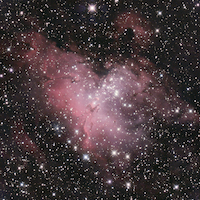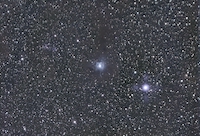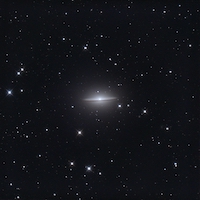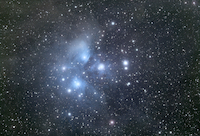
M16
|
07/09/2023
Messier 16, NGC 6611 - Eagle
Nebula, Star Queen Nebula
Messier 16 is a conspicuous region of
active star formation appearing in the constellation
Serpens Cauda. This giant cloud of interstellar
gas and dust is commonly known as the Eagle Nebula and
has already created a cluster of young stars. The
nebula is also referred to the Star Queen Nebula and as
IC 4703; the cluster is NGC 6611.
• TPO6RC/ASI533 (56x180s)
• No Filter
• Binned 1x1
• Acquired using
AstroImager/AstroGuider/AstroTelescope/Astrometry Suite
for Mac
• Processed in SiriL &
Apple Preview
|

NGC 7023 (Iris Nebula)
|
03/19/2024
NGC 7023 - Iris Nebula, Reflection nebula in Cepheus
The illuminating star
of the nebula, HD 200775, is a 10 solar mass star
embedded in a region surrounded by an ambient
molecular cloud. HD 200775 is a B3 type pre-main
sequence star known as a Herbig Be star. HD
200775 is one of the brightest Herbig Be stars known
with a temperature of 17,000 degrees Kelvin and has
carved out a cavity at the center of the molecular
cloud. The cavity is about 5 by 2.5 light years
in dimension and lies in a northeast-southwest
orientation.
• AT72EDII/ASI294 (44x300s)
• No Filter
• Binned 1x1
• Acquired using
AstroImager/AstroGuider/AstroTelescope/Astrometry
Suite for Mac
• Processed in SiriL
& Apple Preview
|
|
M101
|
04/04/2024
M 101 (NGC 5457), the Pinwheel
Galaxy, is a type Sc spiral galaxy in Ursa Major.
Discovered in 1781 by Mechain and catalogued the same
year by Messier, M 101 is one of the finest examples of
a face-on spiral in the heavens. A giant pinwheel
of stars resembling the Milky Way in size and shape,
this spiral appears almost face-on to our view. M
101 has multiple spoke-like arms that extend outward to
a diameter of one third degree. The arms are
dotted with bright nebulae, star clouds, and dust
lanes. At a distance of 18 million light-years,
the galaxy would measure about 100,000 light-years in
size.
• AT-8IN/ASI533 (120s)
• 13xL, 22xR, 20xG, 65xB
• Binned 1x1
• Acquired using NINA
• Processed in SiriL &
Apple Preview |

NGC 4567 (Siamese Twins)
|
04/04/2024
NGC 4567 - Siamese Twins
sometimes called the Butterfly Galaxies in the
constellation Virgo. These unbarred spiral
galaxies are in the early stages of galactic collision
and merger. They are about 60 million light years
away and it's estimated that in about 500 million years
they will coalesce into a single, large elliptical
galaxy.
• TPO6RC/ASI533 (72x120s)
• No Filter
• Binned 1x1
• Acquired using
AstroImager/AstroGuider/AstroTelescope/Astrometry Suite
for Mac
• Processed in SiriL &
Apple Preview
|

M104 Sombrero Galaxy
|
04/04/2024
NGC 4594, M 104, is a type Sab spiral galaxy in the
constellation Virgo. It is known as the famous
"Sombrero Galaxy" for its edge-on appearance. M 104 is
inclined only about 6 degrees to our line of sight and
extends about 8 arc minutes in size.. The dark band across
the galaxy's center is composed of gas and obscuring
dust. M 104 is at a distance of 55 million
light-years and has a diameter of 120,000 light-years.
• TPO6RC/ASI533 (38x300s)
• No Filter
• Binned 1x1
• Acquired using
AstroImager/AstroGuider/AstroTelescope/Astrometry Suite
for Mac
• Processed in SiriL &
Apple Preview
|

M45 Pleiades
|
12/06/2024
The Pleiades in Taurus, M45, NGC 1432, consists of 7 to 10
stars visible to the naked eye. Photographically,
the cluster contains hundreds of members enveloped in
nebulosity. The bluish glow in the Pleiades is
caused by interstellar dust, which shines by reflection
from the nearby stars. The entire group is contained
in a 20 light-year diameter sphere, and is at a distance
of approximately 410 light-years. The Pleiades is
among the youngest of open clusters with an estimated age
of about 20 million years old.
• AT72EDII/ASI294 (120x180s)
• No Filter
• Binned 1x1
• Acquired using
AstroImager/AstroGuider/AstroTelescope/Astrometry Suite
for Mac
• Processed in SiriL w/StarNet
Processing & Apple Preview
|
|
|